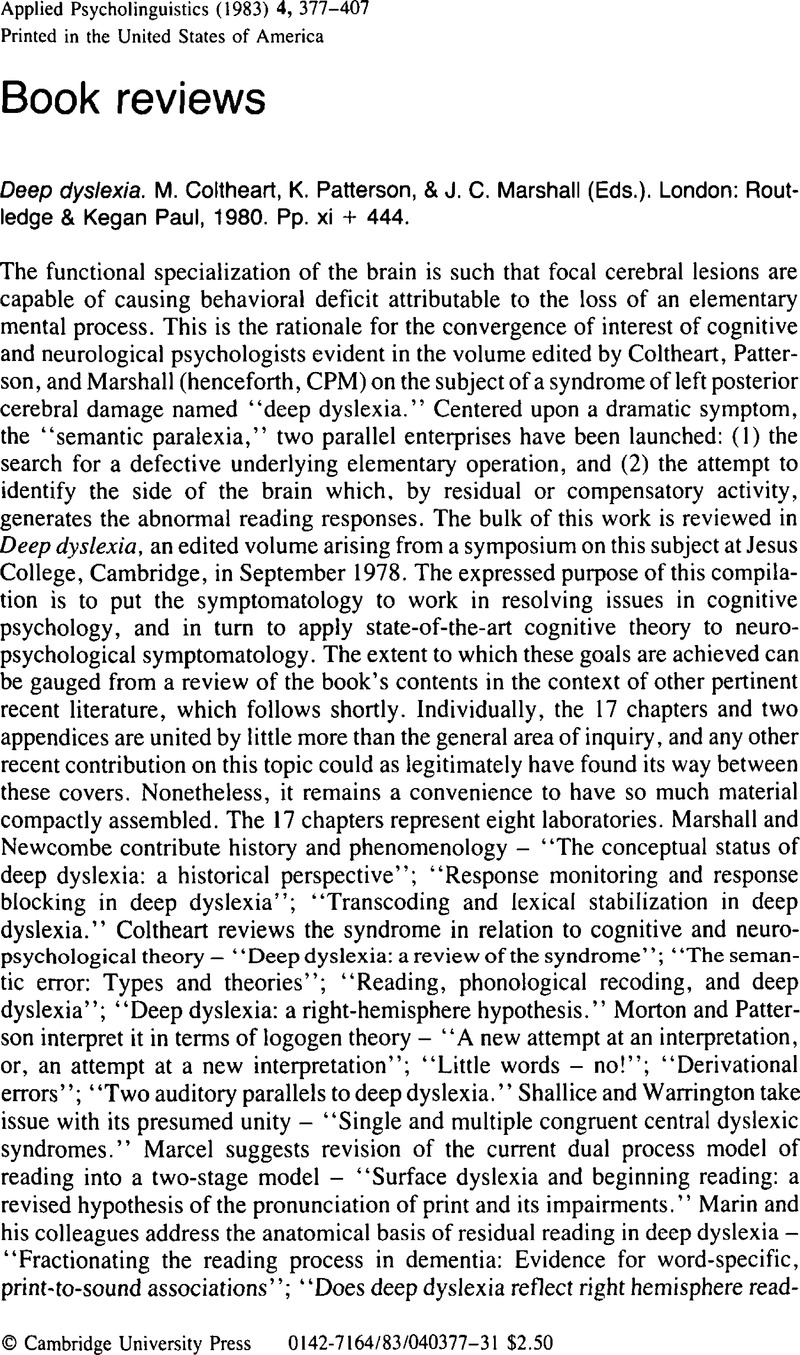No CrossRef data available.
Article contents
Deep dyslexia. M. Coltheart, K. Patterson, & J. C. Marshall (Eds.). London: Routledge & Kegan Paul, 1980. Pp. xi + 444.
Published online by Cambridge University Press: 28 November 2008
Abstract
An abstract is not available for this content so a preview has been provided. Please use the Get access link above for information on how to access this content.

- Type
- Book Reviews
- Information
- Copyright
- Copyright © Cambridge University Press 1983
References
REFERENCES
Allport, D. A. On knowing the meaning of words we are unable to report: The effects of visual masking. In Dornic, S. (Ed.), Attention and performance VI. Hillsdale, N.J.: Erlbaum, 1977.Google Scholar
Barry, C., & Richardson, J. T. E. Reading consistency in a deep dyslexic patient. Proceedings, Experimental Psychology Society, St. Andrews Meeting, 1982.Google Scholar
Bishop, D. V. M.Linguistic impairment after left hemidecortification for infantile hemiplegia? A reappraisal. Quarterly Journal of Experimental Psychology, 1983, 35a, 199–208.CrossRefGoogle ScholarPubMed
Czopf, J.Uber die Rolle der nicht dominanten Hemisphäre in der Restitution der Sprache der Aphasischen. Archives für Psychiatrie and Nervenkrankheit, 1972, 216, 162–171.CrossRefGoogle Scholar
Dennis, M.Capacity and strategy for syntactic comprehension after left or right hemidecortication. Brain and Language, 1980, 10, 287–317.CrossRefGoogle ScholarPubMed
Dennis, M., & Kohn, B.Comprehension of syntax in infantile hemiplegics after cerebral decortication: Left hemisphere superiority. Brain and Language, 1975, 2, 475–486.CrossRefGoogle ScholarPubMed
Donders, F. C.Die Schnelligkeit Psychischer Prozesse. Archives für Anatomie und Physiologie und Wissenschaftliche Medicin, 1868, 657–681.Google Scholar
Gibson, E. J., & Levin, H.The psychology of reading. Cambridge, Mass.: M.I.T. Press, 1975.Google Scholar
Kinsbourne, M.A model for the mechanism of unilateral neglect of space. Transactions of the American Neurological Association, 1970, 95, 143–145.Google Scholar
Kinsbourne, M.The minor cerebral hemisphere as a source of aphasie speech. Archives of Neurology, 1971, 25, 302–306.CrossRefGoogle Scholar
Kinsbourne, M. Mechanisms of hemispheric interaction in man. In Kinsbourne, M. and Smith, W. L. (Eds.), Hemispheric disconnection and cerebral function. Springfield: Thomas, 1974.Google Scholar
Kinsbourne, M. Hemi-neglect and hemispheric rivalry. In Weinstein, E. A. and Friedland, R. P. (Eds.), Hemiinattention and hemisphere specialization: Advances in neurology. New York: Raven Press, 1977.Google Scholar
Kinsbourne, M., & Warrington, E. K.A tachistoscopic study of visual inattention. Journal of Physiology, 1961, 156, 33–34.Google Scholar
Kinsbourne, M., A variety of reading disabilities associated with right hemisphere lesions. Journal of Neurology, Neurosurgery and Psychiatry, 1962, 25, 339–344.Google ScholarPubMed
Leicester, J., Sidman, M., Stoddard, L. T., & Mohr, J. P.Some determinants of visual neglect. Journal of Neurology, Neurosurgery and Psychiatry, 1969, 32, 580–587.Google ScholarPubMed
Marcel, A. J. Perception with and without awareness. Paper to the Experimental Psychology Society, Stirling, 07 1974.Google Scholar
Marshall, J. C., & Newcombe, F.Patterns of paralexia. Journal of Psycholinguistic Research, 1973, 2, 175–199.CrossRefGoogle ScholarPubMed
Moscovitch, M. Language and the cerebral hemispheres: Reaction-time studies and their implications for models of cerebral dominance. In Pliner, T. A. and Kramer, Z. (Eds.), Communication and affect: Language and thought. New York: Academic Press, 1973.Google Scholar
Nolan, K. A., & Caramazza, A.Modality-independent impairments in word processing in a deep dyslexic patient. Brain and Language, 1982, 16, 237–264.CrossRefGoogle Scholar
Searleman, A.A review of right hemisphere linguistic capabilities. Psychological Bulletin, 1977, 84, 504–528.CrossRefGoogle ScholarPubMed
Smith, A. Dominant and nondominant hemispherectomy. In Kinsbourne, M. and Smith, W. L. (Eds.), Hemisphere disconnection and cerebral function. Springfield, Ill., 1974.Google Scholar
Sparks, R. W., Goodglass, H., & Nickel, B. Right versus left hemisphere lesion effects in dichotic listening. Proceedings, 78th Annual Convention, American Psychological Association, 1970.Google Scholar
Sternberg, S. The discovery of processing stages: Extensions of Donders' method. In Koster, W. G. (Ed.) Attention and performance II. Amsterdam: North-Holland, 1969.Google Scholar
Weisenburg, T., & McBride, V. E.Aphasia: A clinical and psychological study. New York: Commonwealth Fund, 1935.Google Scholar
Wickens, D. D.Encoding categories of words: An empirical approach to meaning. Psychological Review, 1970, 77, 1–15.CrossRefGoogle Scholar
Zajonc, R. B.Feeling and thinking: Preferences need no inferences. American Psychologist, 1980, 35, 151–175.CrossRefGoogle Scholar


